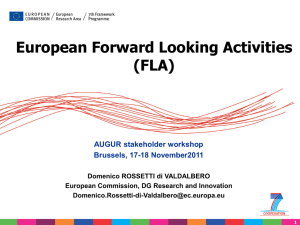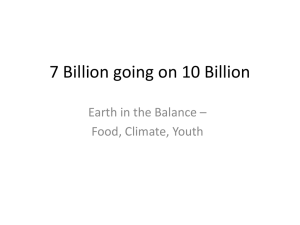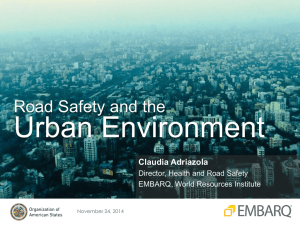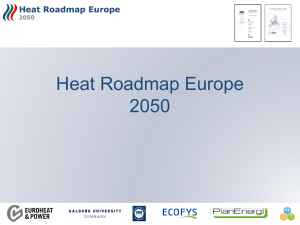EU Energy Roadmap 2050
advertisement
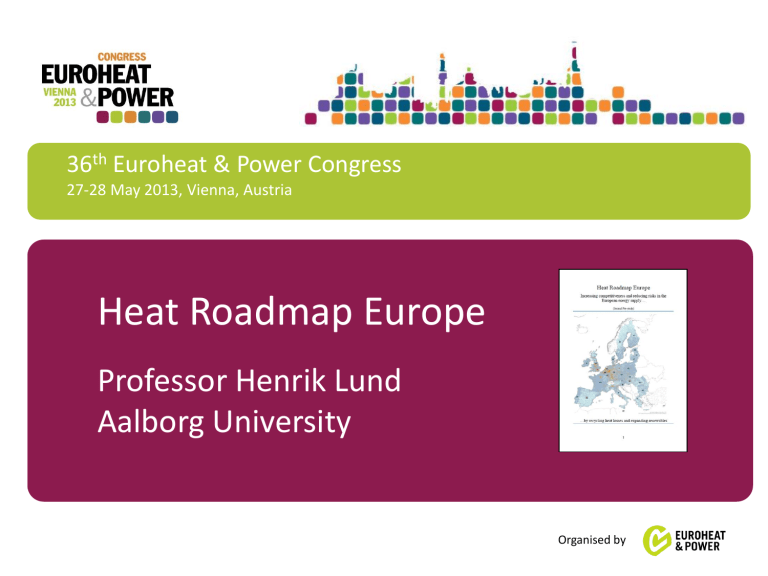
36th Euroheat & Power Congress 27-28 May 2013, Vienna, Austria Heat Roadmap Europe Professor Henrik Lund Aalborg University Organised by Pre-study 2 Heat Roadmap Europe Aalborg University David Connolly Brian Vad Mathiesen Poul Alberg Østergaard Bernd Möller Steffen Nielsen Henrik Lund Planenergi Daniel Trier Halmstad University Urban Persson Sven Werner Ecofys Germany GmbH Jan Grözinger Thosmas Boersmans Michelle Bosquet Motivation Consensus/general: Energy Road Map 2050 (EU”Combined heat & power (CHP) and district heating (DH) are important” commission) Road Map 2050 (McKinsey et.al) . . . but fail to quantify to which extent The energy report – 100% these options can be used in the renewable energy by 2050 (WWF)future energy system . . . Energy Technology Perspectives 2010 (IEA) The European Commission in the Energy Roadmap 2050 communication: “An analysis of moreOutlook ambitious energy World Energy (IEA)efficiency measures and costoptimal policy is required. Energy efficiency has to follow its economic Deciding Future – Energy Policy potential. Thisthe includes questions on to what extent urban and spatial planning can contribute Scenarios to 2050to saving energy in the medium and long term; how to find the cost-optimal policy choice between insulating buildings to use less heating and cooling and systematically using the waste heat of electricity generation in combined heat and power plants.” Methodology GIS Mapping Energy System Modelling District Heating Demands BAU (References) District Heating Resources District Heating Alternatives Indicate Costs Results (PES, CO2, Costs) GIS based information Urban areas (Heating Demands) Power and Heat Generation Waste Management Industrial waste heat potential Geothermal heat Solar Thermal Energy System Analyses Model Wind production Eltra 1996 (2042 MWh pr MW) 500 MWh/h 400 300 200 100 0 0 1098 2196 3294 4392 5490 6588 7686 8784 7686 8784 7686 8784 Hours Wind production Eltra 2000 (2083 MWh pr MW) 2000 PV production Sol300 2001 MWh/h 1500 300 kWh/h 250 1000 500 200 0 150 Electricity storage system Import/ Export 1098 fixed and variable 0 www.EnergyPLAN.eu Hydro water Hydro storage Hydro 100 power50plant 0 0 3294 4392 3294 4392 Cooling demand MWh/h 1500 PP 4 500 3 300 2 250 1 200 0 CHP 0 1098 2196 150 3294 4392 100 Hours 5490 Heat pump and electric 6588 7686 boiler Cooling device 0 0 1098 2196 3294 4392 0 estimated year 2001 Wave Power 0 1098 2196 kWh/h pr. m wave front RES heat 3294 6 5490 Hours 8784 Heat demand 50 Boiler 4392 5490 Hours Heat 6588 storage 7686 8784 5 Electrolyser 4 3 H2 storage 2 1 Transport demand Cars 0 0 1098 2196 3294 4392 5490 6588 7686 6588 Wind production Eltra 2001 (1964 MWh pr MW) 6588 7686 8784 5490 PV production Sol300 1000 2002 5 5490 Electricity demand Hours 2000 Hours 6 kWh/h Fuel 2196 Wave Power estimated year 1999 kWh/h pr. m wave front RES electricity 1098 2196 8784 Hours Industry Process heat demand 6588 Step 1: (Energy Efficiency) - Increasing DH to 30% then 50% - Increasing CHP - Using Oil/Natural gas in CC-CHP Showing DH benefits in 2 steps Step 2: (Utilise waste and RE sources) - Industrial waste heat - Waste incineration - Geothermal heat - Large-scale Solar Thermal Future: EU Energy Roadmap 2050 Completed for the European Commission in 2011, by the National Technical University in Athens Presents 6 energy scenarios for the EU27: Reference: Business-as-usual CPI: Updated business-as-usual EE CCS Nuclear High RE 2030/2050 Modelling EU CPI PRIMES Data 2030 & 2050 Model EU Energy Roadmap 2050 Current Policy Initiatives (CPI) District Heating Alternatives 2010 = 12% DH 2030 = 30% DH 2050= 50% DH Results (PES, CO2, Costs) HRE1 Conclusion: 50% DH and CHP Decrease primary energy supply and LESSfuels FUEL and CO2 especially fossil emissions Decrease annual costs of energy in LESS MONEY Europe by approximately €14 Billion in 2050 Create additional jobs over MORE EU220,000 JOBS the period 2013-2050 Further integration MORE REof RES Annual EU27 costs for heating buildings in 2010 to 2050 140 Cost and Jobs: Annual costs [Billion €] 120 100 Annual investment costs 80 Fixed operation costs 60 CO2 emission costs Marginal operation cost 40 Fuel 20 0 IEA 2010 EU CPI HRE RE EU CPI 2030 Saved fuel costs of annual approx. 30 Billion EUR in 2050 In total cost are reduced by 14 Billion EUR in 2050 Additional investments of a total of 500 billion EUR Additional jobs from to 2013 to 2050: 8-9 million man-year in total Approx. 220,000 jobs. HRE RE 2050 Future: EU Energy Roadmap 2050 Completed for the European Commission in 2011, by Is districtTechnical heating a goodUniversity idea if we implement a lot of energy theHRE2: National in Athens efficiency in the buildings? Presents 6 energy scenarios for the EU27: Reference: Business-as-usual CPI: Updated business-as-usual Energy Efficiency (EU-EE) Carbon Capture & Storage Nuclear High Renewable Energy Energy Modelling EU-EE PRIMES Data 2030 & 2050 Model EU Energy Roadmap 2050 Energy Efficiency (EE) District Heating Alternatives 2010 = 12% DH 2030 = 30% DH 2050= 50% DH Results (PES, CO2, Costs) Key Measures in EU-EE Scenario High renovation rates for existing buildings due to better/more financing and planned obligations for public buildings (more than 2% refurbishment per year) Passive houses standards after 2020 Obligation of utilities to achieve energy savings in their customers' energy use over 1.5% per year (up to 2020) Strong minimum requirements for energy generation, transmission and distribution including obligation that existing energy generation installations are upgraded to the EU-EE Scenario Heat Demand Concerns Hot water demand decreases by 50% between 2010 and 2050 Specific Heat Demands reduce by 70% between 2010 and 2050 EU-EE Scenario 63% Drop in Heat Demands Cost B€300/year 2010-2050 Additional Cost of Energy Efficiency Measures (€/kWh Saved) 3.00 2.50 2.00 1.50 1.00 0.50 0.00 0% 10% 20% 30% 40% 50% Heat Demand Reduction (%) 60% 70% 80% HRE-EE Hot Water Growth = +16% Residential and non-residential buildings is expected to grow by 32% and 42% respectively between 2015 and 2050 Population will grow by 3.2% between 2010 and 2050. Individuals are likely to take more showers and baths in the future than they do today. People are not expected to live with one another as much in the future. At present, there are regions in Europe where the use of hot water is limited due to technical and financial limitations. HRE-EE Space Heating = -47% Implementing District Heating 1. Individual boilers are replaced by district heating: 30% in 2030 and 50% in 2050 Individual heat pumps are not replaced 2. Individual cooling units are replaced with district cooling. 10% in 2030 and 20% in 2050 Natural cooling and absorption heat pumps are both used. Heat Demand by Source 4 000 Heat Demands (TWh/year) 3 500 3 000 Geothermal Heat Pumps 2 500 Direct Electricity 2 000 Solar Biomass 1 500 Gas Oil 1 000 Solids District Heating 500 0 EU-EE HRE-EE 2030 EU-EE HRE-EE 2050 Implementing District Heating 3. New DH production facilities are constructed: CHP, boilers, heat pumps, and thermal storage. 4. Additional resources can now be utilised by the district heating network: Industrial surplus heat: 100 TWh/year Direct geothermal heat: 100 TWh/year Waste incineration: 150 TWh/year Large-scale solar thermal: 100 TWh/year Wind power for large-scale heat pumps: 65 TWh/year District Heating Supply for Residential and Services Buildings (TWh/year) EU-EE vs. HRE-EE DH Supply 1 800 1 600 1 400 1 200 Industry Waste Geothermal Solar Heat Pumps Boiler CHP 1 000 800 600 400 200 0 EU-EE HRE-EE 2030 EU-EE HRE-EE 2050 23 Results EU-EE vs. HRE-EE Primary Energy Supply & CO2 Coal Oil Gas Biomass Waste RES 18 000 3 000 15 000 2 500 12 000 2 000 9 000 1 500 6 000 1 000 3 000 500 0 0 EU-EE Brussels, Belgium HRE-EE 2030 EU-EE HRE-EE 2050 24 Carbon Dioxide Emissions (X, Mt/year) Primary Energy Supply (TWh/year) Nuclear EU-EE vs. HRE-EE Fossil Fuels Coal Oil Gas Biomass Waste 18 000 RES 3 000 15 000 2 500 12 000 2 000 9 000 1 500 6 000 1 000 3 000 500 0 0 EU-EE Brussels, Belgium HRE-EE 2030 EU-EE HRE-EE 2050 25 Carbon Dioxide Emissions (X, Mt/year) Primary Energy Supply (TWh/year) Nuclear EU-EE vs. HRE-EE Additional Resources Heat Available from Unconventional Resources due to District Heating* (TWh/year) Industry Waste Incineration^ Geothermal Large-Scale Solar 600 500 400 300 200 100 0 EU-EE Brussels, Belgium HRE-EE 2030 EU-EE HRE-EE 2050 26 Total Costs for Heating and Cooling in the Residential and Services Sectors (B€/year) EU-EE vs. HRE-EE Heat & Cooling Costs -15% Energy Efficiency Investments Cooling System Investments Fuel Heating System Investments Centralised Electricity & Heat Plants CO2 800 700 600 500 400 300 200 100 0 Brussels, Belgium EU-EE HRE-EE 2030 EU-EE HRE-EE 2050 27 Case Study: Århus Legend District heating area Built up areas Aarhus municipality Conclusions District heating is an attractive solution in areas with a high heat density District heating can be seen as an efficiency measure similar to reductions in heat demand, because it enables the use of fuels in a more efficient way Heat reductions in buildings can be combined with district heating so that it is competitive with individual solutions Conclusions (1) If we continue under a business-as-usual scenario, then district heating can: Reduce the PES Reduce the CO2 emissions Reduce the costs of the energy system Use more renewable energy Conclusions (2) If we implement a lot of energy efficiency measures, then district heating will: Meet the same goals, ie: Utilise the same amount of fossil fuels Enable the same CO2 emission reductions Cost approximately 10% less How to get the report…. www.heatroadmap.eu

